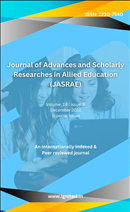Senses in architecture as a vehicle to enhance students’ well-being in institutional spaces
Exploring the Role of Architecture in Enhancing Students' Well-being through Sensory Design
Keywords:
senses in architecture, students' well-being, institutional spaces, mental health, built environments, architecture and design, senses, light and nature, case studies, holistic well-being, constructive approachesAbstract
Recently, mental health concerns are increasingly evident among tertiary students. However,some institutions seldom notice the crucial role of designing an environment specifically to enhancepersonal well- being or to help with their mental health issues. According to research, the human bodydefines or recognises spaces through the stimulation of the senses. The human body intends toseamlessly grasp the environment as an overall atmosphere, ambience, feeling, or mood. Therefore, thesenses play a vital role in spaces helping users to engage better in the environment. This researchexplores the importance of enhancing spaces to increase well-being in the built environments to supportsound mental health for students. It focuses on how architecture and design can support well-being inan institutional setting. This study aims to understand the impact that senses, light and nature have onarchitecture to achieve holistic well-being for users by studying various case studies. Qualitativeresearch methods, including precedent analysis and literature review, are used to understand the role ofan individual's experience in a built environment. The study explores the constructive approaches aimingto understand various atmospheres and affect which are created through senses. Finally, this paperprovides recommendations for architects to include during designing and to create a community-widewell-being effort for the students in future.Published
2022-12-01
How to Cite
[1]
“Senses in architecture as a vehicle to enhance students’ well-being in institutional spaces: Exploring the Role of Architecture in Enhancing Students’ Well-being through Sensory Design”, JASRAE, vol. 19, no. 6, pp. 111–114, Dec. 2022, Accessed: Nov. 05, 2024. [Online]. Available: https://ignited.in/index.php/jasrae/article/view/14149
Issue
Section
Articles
How to Cite
[1]
“Senses in architecture as a vehicle to enhance students’ well-being in institutional spaces: Exploring the Role of Architecture in Enhancing Students’ Well-being through Sensory Design”, JASRAE, vol. 19, no. 6, pp. 111–114, Dec. 2022, Accessed: Nov. 05, 2024. [Online]. Available: https://ignited.in/index.php/jasrae/article/view/14149









